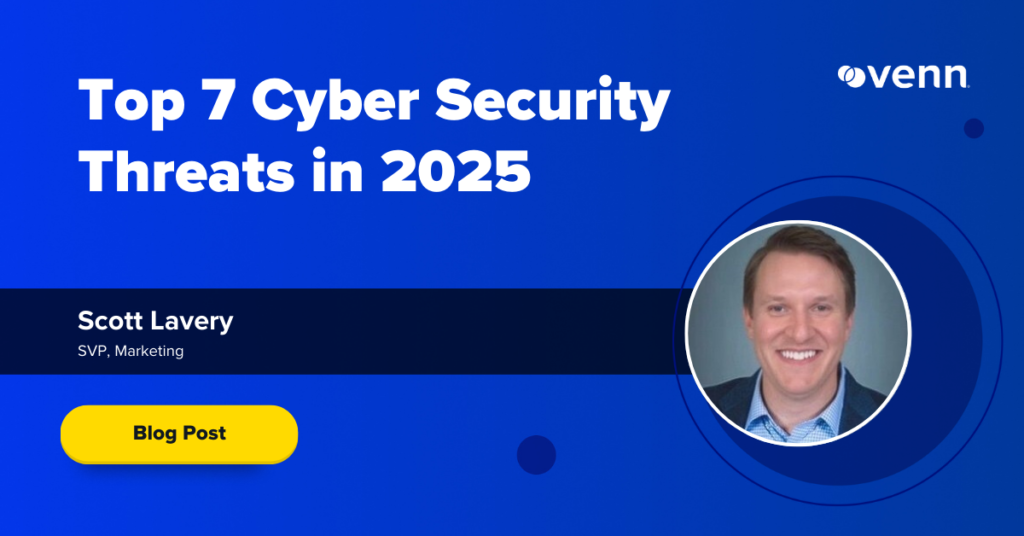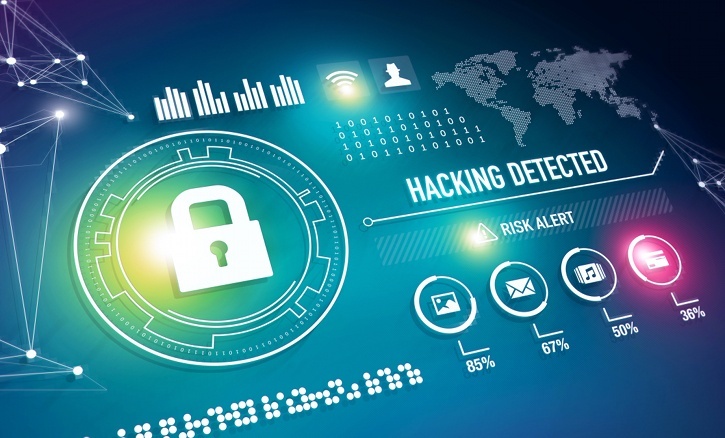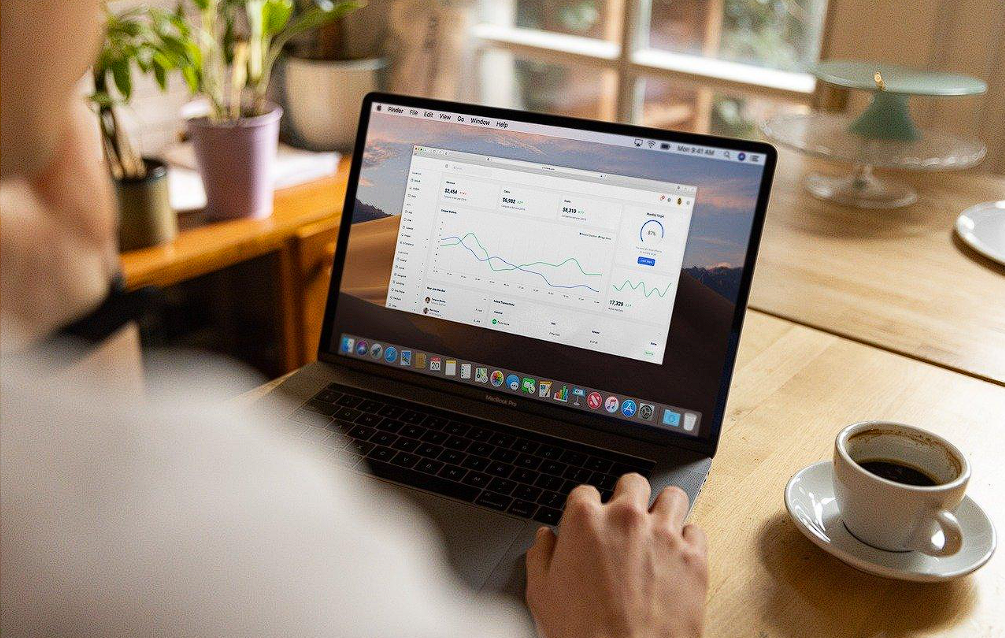Secure Enclave Cyber Security: Reduce Risks in 2025 – Venn

IT leaders understand that security is a critical component of their systems and technological choices, now more than ever. The main challenge is understanding all the threats and choosing the right solutions to prevent them. While cyber risks vary by industry and geography, every organization must defend against fundamental threats.
In this blog, we outline the top cybersecurity risks of 2025 and strategies to protect against them. By the end, you’ll have a clear roadmap to securing your organization for the months and years ahead.
Top 7 Cyber Security Threats in 2025
Cyber threats are evolving faster than ever, and 2025 is shaping up to bring new challenges for security teams. From the rise of unmanaged devices to the growing risk of insider threats and zero-day exploits, organizations must stay ahead of emerging risks and ensure data protection—or risk falling behind.
Here are the top seven cybersecurity threats to watch out for in 2025.
1. Unmanaged Devices
The rise of BYOD (Bring Your Own Device) has given employees and contractors more flexibility—but it has also created a major security challenge. Unmanaged devices, which lack IT control and standard security configurations, significantly increase the risk of data breaches, malware infections, and unauthorized access. Unlike company-issued hardware, these personal laptops and desktops may not have up-to-date security patches, endpoint protection, or proper access controls. As remote work and global workforces continue to expand, organizations must find ways to secure corporate data on unmanaged devices without compromising user privacy or productivity.
Solution
Securing BYOD shouldn’t mean adding complexity for IT or restricting flexibility for users. The key is to create a protected environment where corporate data remains secure, even on unmanaged devices. Secure enclaves provide a streamlined way to achieve this, allowing companies to enforce security controls without taking over personal laptops.
A Secure Enclave is a virtual wrapper that separates work from personal activities on BYOD laptops. In this setup, even if attackers manage to compromise the personal side of an endpoint—perhaps through phishing, malware, or other deceptive tactics—they would be unable to access any corporate resources. This isolation ensures that breaches on the personal front do not spill over into sensitive work areas.
2. Zero-Day Exploits
Zero-day exploits are among the most dangerous cyber threats because they target undiscovered vulnerabilities in software before developers have a chance to patch them. These attacks give cybercriminals a critical window to infiltrate systems, plant malware, and launch data breaches—often without detection. Since traditional security tools rely on known threat signatures, zero-day attacks can bypass standard defenses, making them particularly difficult to prevent. As attackers continue to find and exploit hidden flaws, organizations must adopt proactive security measures, such as continuous monitoring, threat intelligence, and isolation strategies, to minimize the impact of zero-day threats.
Solution
While zero-day exploits are unpredictable, organizations can take proactive steps to reduce their exposure and mitigate potential damage. A strong security posture includes timely patch management, in-depth vulnerability assessments, and continuous attack surface monitoring to identify weaknesses before attackers do. Threat intelligence feeds and anomaly-based detection tools, such as UEBA and EDR, help detect suspicious activity in real time, while a zero-trust architecture minimizes the impact of a breach by enforcing strict access controls.
Secure enclaves provide an additional layer of defense by isolating corporate applications and data from the rest of the endpoint. Even if a zero-day exploit compromises the underlying operating system, attackers cannot access sensitive work environments within the enclave. By reducing the attack surface and containing threats, secure enclaves help organizations limit the damage of zero-day attacks and maintain control over critical business data.
3. Insider Threats
Insider threats are actions within an organization that can jeopardize security. These actions can be unintentional—for example, employees falling victim to social engineering, such as a phishing email that tricks them into revealing login credentials. Well-meaning employees may also accidentally expose sensitive data by misconfiguring cloud settings or sharing files with the wrong recipients. On the other hand, insider threats can also be malicious, such as a disgruntled employee deliberately leaking confidential information.
According to the Verizon DBIR 2024, 68% of breaches in 2024 involved a non-malicious human element. Insider cyber threats are particularly challenging to manage because employees and contractors often have legitimate access to systems and sensitive data, making their actions harder to detect and mitigate.
Solution
Risk inside the Secure Enclave—visually indicated by a Blue Border in Venn’s case—is also significantly reduced. Actions like copying and pasting data to external environments or moving files out of the secure boundary are blocked, preventing accidental or intentional data exfiltration. Additionally, companies maintain full control over browsing activities within Venn’s Blue Border, restricting access to phishing sites and other malicious web destinations.
4. Poor Permission Controls
Traditional perimeter-based security models assume that threats exist outside the network while everything inside is inherently trusted. This outdated approach falls apart in modern environments where employees, contractors, and third parties all require access to critical systems—often from personal or unmanaged devices. Without strict permission controls, users may have direct access to far more data and resources than they actually need, increasing the risk of accidental or malicious misuse.
For example, an employee with broad access might unintentionally expose sensitive data by misconfiguring cloud storage settings, while a compromised contractor account could give attackers a direct pathway into critical systems. Without granular, role-based access controls and continuous monitoring, organizations leave themselves vulnerable to data breaches, insider threats, and privilege abuse.
Solution
Venn’s Secure Enclave provides a critical security layer by serving as a private gateway for accessing company applications and web apps. Unlike traditional perimeter-based security, which implicitly trusts users inside the network, Venn enforces a zero-trust model by requiring authentication before granting access to sensitive systems. This approach eliminates the risks associated with broad, network-wide access by restricting permissions on a case-by-case basis, ensuring users can only reach the resources necessary for their role.
By integrating key principles of zero trust and Secure Access Service Edge (SASE), Venn strengthens access control and visibility. Every authentication request is evaluated individually, reducing the attack surface while maintaining seamless usability. This model also enables detailed auditing and monitoring, ensuring that all access is logged and reviewed to detect anomalies. By moving beyond outdated perimeter defenses, Venn provides a modern security framework that aligns with today’s cloud-based and remote work environments.
5. Data Exfiltration
Data exfiltration is the unauthorized transfer of data from within an organization to an external destination. This can occur either intentionally or accidentally through various methods such as email, USB drives, screenshots, or even sophisticated malware designed to stealthily siphon data. The consequences of data exfiltration are severe, including financial loss, reputational damage, and regulatory penalties, especially with the increasing emphasis on data privacy laws and compliance requirements for various industries.
Solution
Secure Enclaves protect sensitive data from exfiltration by enforcing strict controls and monitoring within their environments. By creating a clear separation between personal and work environments, Secure Enclaves ensure that network data within the secure boundary cannot be easily transferred to untrusted areas, preventing accidental or intentional data leaks. Within the Enclave, policies can be enforced to restrict data movement, tightly controlling actions like copying, pasting, downloading, and uploading to ensure that data remains within the secure environment.
Moreover, policies can continuously monitor user activities for any suspicious behavior that might indicate an attempt to exfiltrate data. Alerts can be generated for activities such as unusual data transfer volumes or access to unauthorized applications, enabling timely intervention. Additionally, all data within the Secure Enclave is encrypted, with access governed by stringent security measures. Encrypted data remains protected at all times, ensuring that only authorized personnel can interact with sensitive information. These measures significantly reduce the risk of data exfiltration and maintain data security within a controlled and monitored environment.
6. Malware
Malware poses severe threats to cybersecurity by infiltrating systems deeply and operating stealthily to evade detection. This deep integration allows malicious actors to execute attacks undetected, such as stealing customer data, logging keystrokes, or even disabling security measures. Advanced malware variants also exploit vulnerabilities in software or hardware, using sophisticated techniques to bypass traditional security measures and intrusion detection systems.
Solution
Secure Enclaves operate in highly isolated hardware environments within the device, which is designed to be tamper-resistant. Even if malware infects the main operating system or other parts of the device, it can’t access or manipulate the data and code within the enclave. Sensitive data within the enclave remains protected, ensuring that any malware outside its boundaries cannot access or compromise it.
In addition, a Secure Enclave can be configured to enforce strict security policies on the device, commonly referred to as ‘device hygiene.’ Device hygiene can include checks for security updates, the integrity of critical system files and the presence of security software. By ensuring that the device meets certain security standards before allowing access to sensitive functions and data, Secure Enclaves minimize the risk of malware infection.
Finally, in instances where a device is lost, stolen, or irrevocably compromised, a Secure Enclave can facilitate the remote wiping of sensitive data, rendering it unrecoverable. This capability helps prevent data breaches and limits potential damage.
7. Poor Compliance Management
Ineffective compliance management can expose organizations to significant security and financial risks, increasing the likelihood of cyberattacks and operational disruptions. Industries such as finance, healthcare, legal, and e-commerce must navigate stringent regulations governing data privacy, security practices, and reporting requirements. Failure to properly manage these obligations can result in hefty financial penalties, reputational damage, and legal repercussions.
Additionally, poor compliance management can complicate efforts to secure cyber insurance coverage. Insurers often require organizations to demonstrate adherence to specific security standards and regulatory frameworks as part of their risk assessment. Without meeting these requirements, organizations may face higher premiums or struggle to obtain adequate coverage against cyber threats and data breaches.
Solution
With Venn’s Blue Border, companies can maintain compliance with the strictest cybersecurity standards, including: SOC 2 Type II, HIPAA, SEC, FINRA, NAIC, NYS DFS and Mass 201 CMR 17.00. These ensure enterprises can trust the platform to manage and protect sensitive data effectively. This allows for operational continuity and maintains the confidence of customers, stakeholders and legal authorities.
Protect Your Data With a Secure Enclave
As threats evolve, traditional security models fall short. Secure enclaves offer a modern solution, providing organizations with a way to secure corporate data on unmanaged devices without disrupting user experience. By adopting this approach, companies can reduce risk, enhance compliance, and future-proof their cybersecurity strategies in 2025 and beyond.
Find out how Venn’s Blue Border can help protect you in 2025.
More Blogs


